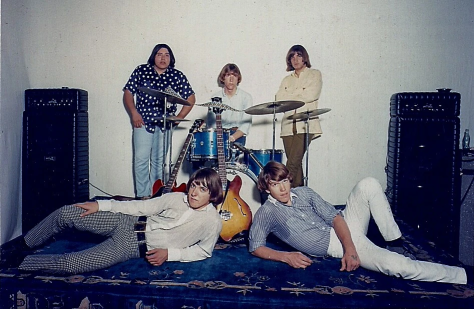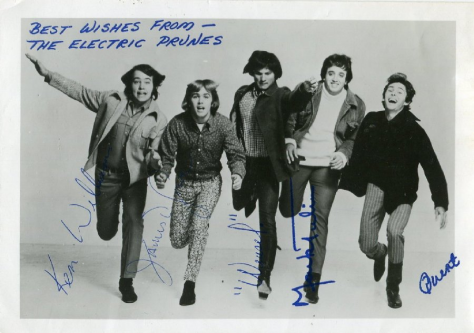Zakary Thaks has turned out to be one of my favorite obscure bands I’ve discovered lately. They seem to be really well regarded by fans of garage and psych music, so it’s a shame there was not the chance for them to record albums. They started recording music in July 1966, so if they had recorded one album a year, we’d have probably four proper albums and a handful of strays that might add on an album or two. As such, some of these songs come from slightly odd sources and don’t have as much cohesion as I’d like. The first is basically a greatest hits, mostly being singles and b-sides. It is the main reason I love this band, due to the fiery playing with little studio touches. There are some unreleased cuts and interestingly three members of Thaks backing someone else. That singer, Mike Taylor, worked with the band a lot and I think these tracks fit close enough to be considered Thaks songs, especially based on something that will come up later. While my Face to Face album is very close to passing as a proper studio album, it mostly being singles makes it not feel like albums of the time. It does help everything was recorded in just over half a year.
Zakary Thaks – Face to Face (1967) – YouTube
TRACKLISTING
SIDE A
- “Bad Girl”
- “I Need You”
- “She’s Got You”
- “It’s the End
- “People Sec. VI”
- “Passage to India”
SIDE B
- “Won’t Come Back”
- “Weekday Blues
- “I’d Only Laugh”
- “Please”
- “Face to Face”
PERSONNEL
- Chris Gerniottis – lead vocals (tracks 1-4, 6-8, 10-11)
- John Lopez – lead guitar (tracks 1-11) (Possibly not on tracks 5, 9)
- Pete Stinson – rhythm guitar (tracks 1-4, 6-8, 10-11)
- Rex Gregory – bass (tracks 1-11)
- Stan Moore – drums (tracks 1-11)
- Mike Taylor – lead vocals (tracks 5, 9)
The second album comes from a video the band recorded of covers. The recordings were not intended for proper release and thus the quality is a bit poor, but it’s a nice oddity to have. If Thaks was able to do one or two albums a year, this would probably not have been released, though there are some official live albums of the time with poor sound quality. The Summer of Love doesn’t have the excuse of capturing the band playing off a live audience of screaming fans, as this is basically just a rehearsal tape.
Zakary Thaks – The Summer of Love (1967) – YouTube
TRACKLISTING
SIDE A
- “I’ve Got Levitation”
- “Sock It To Me Baby”
- “Love Is A Beautiful Thing”
- “Mustang Sally”
- “3/5 Of A Mile”
SIDE B
- “I’m A Man”
- “My Little Red Book”
- “Shake”
- “My Back Pages”
- “Tell Her No”
PERSONNEL
- Chris Gerniottis – lead vocals (tracks 1-10)
- John Lopez – lead guitar (tracks 1-10)
- Pete Stinson – rhythm guitar (tracks 1-10)
- Rex Gregory – bass (tracks 1-10)
- Stan Moore – drums (tracks 1-10)
Not only is this last album very short, but it spans two years! This draws from a period where the band was changing and not making much music. The earliest tracks are the rest of what was recorded with Mike Taylor singing, though I’m unsure if two of them feature Thaks. I have them here as one unverified source says so and none say otherwise directly. After the final single with the classic lineup, Chris and Rex were both fired, then the band almost immediately broke up. You’d think Rex would be embittered, but it seems not as the two members that wanted him gone most got him back in the fold and they formed a power trio. That trio of Rex, Stan, and John recorded, amusingly having been the three members to also be on the Mike songs. That means the Mike recordings have all of an official version of the band. Chris would rejoin near the end. Note that if you took the “Footsteps” and “Mirror” tracks and moved them to the first album, then erased the Mike songs, you’d have all the studio recordings of the classic lineup. I didn’t end up doing that because I wanted everything in order and for this last studio album to not be so extremely dominated by Mike. That does mean that sadly this great band in its best configuration only managed eleven studio tracks! That’s similar numbers to the Big Three.
Zakary Thaks – Everybody Wants to Be Somebody (1969) – YouTube
TRACKLISTING
SIDE A
- “Can You Hear Your Daddy’s Footsteps”
- “Mirror to Yesterday”
- “Gotta Make My Heart Turn Away”
- “I’m Nobody’s Man”
SIDE B
- “My Door”
- “Green Crystal Ties”
- “My Last Day”
- “Outprint”
- “Everybody Wants to Be Somebody”
PERSONNEL
- Chris Gerniottis – lead vocals (tracks 1-2, 8-9)
- John Lopez – lead guitar (tracks 1-9), lead vocals (tracks 5-6) (Possibly not on tracks 3-4, 7)
- Pete Stinson – rhythm guitar (tracks 1-2)
- Rex Gregory – bass (tracks 1-9), lead vocals (tracks 5-6) (Possibly not on tracks 4, 7)
- Stan Moore – drums (tracks 1-9), lead vocals (tracks 5-6) (Possibly not on tracks 4, 7)
- Mike Taylor – lead vocals (tracks 3-4, 7)












